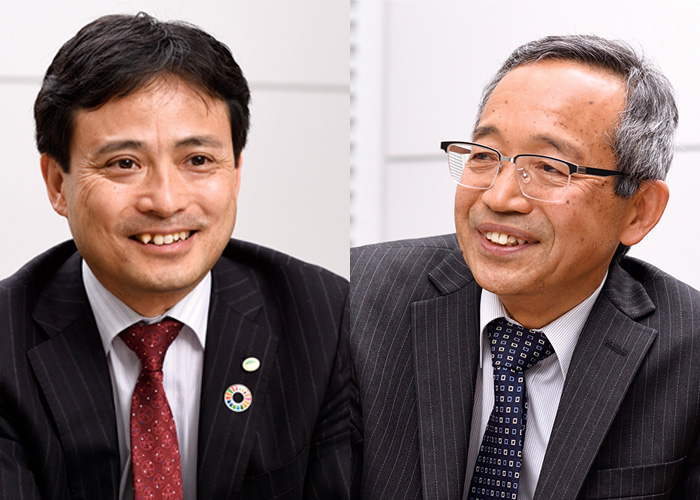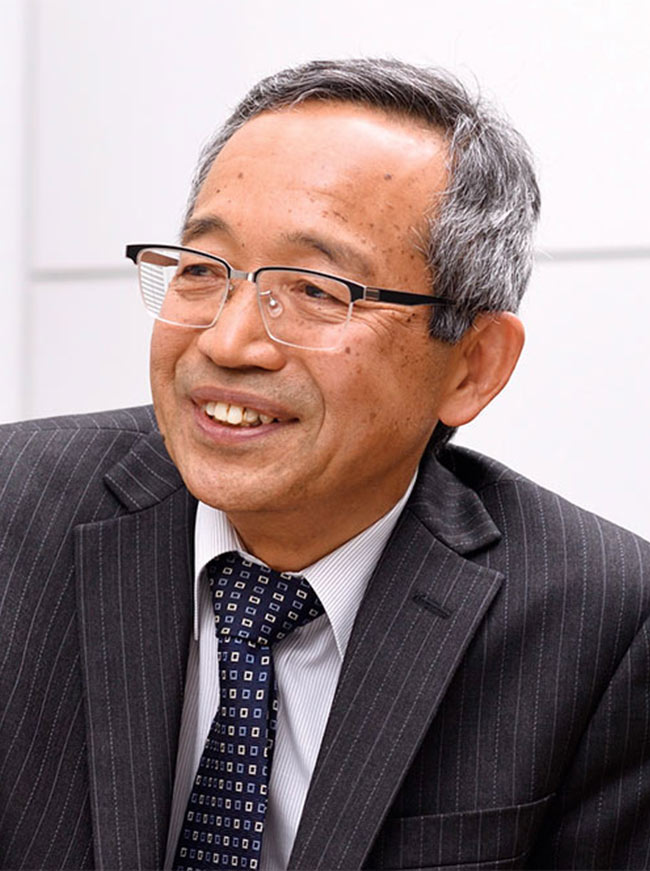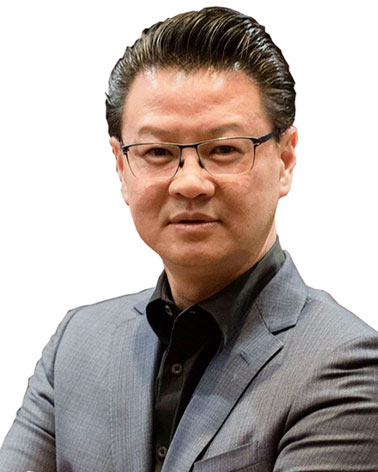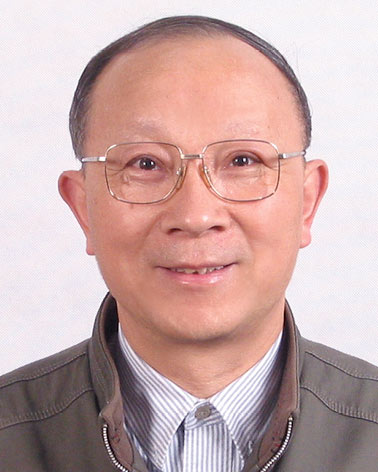COVER STORY:ISSUES1Service as Launch Pad for Spreading Digital TransformationNew Service Concepts for Value Co-creation with Customers
Highlight
Digital transformation has been a key concept in corporate management and many companies have already begun to grapple with it for their business innovation. Michitaka Kosaka, Professor Emeritus at the Japan Advanced Institute of Science and Technology, makes the case that the creation of new services designed to overcome specific issues is more crucial to the success of this transformation than technology-driven approaches, and the latest service science aiming at value co-creation with customers shows the way forward. How should we be thinking about service innovation in this digital age? What factors will be key to the successful global deployment of digital solution services? Masaharu Akatsu, CTO at Hitachi’s Systems & Services Business Division, puts these questions to Professor Kosaka, a leader in the field of service innovation research.

Changing Expectations for Digital Technology
 Michitaka Kosaka
Michitaka Kosaka
Professor Emeritus, Japan Advanced Institute of Science and Technology
Guest Professor, School of Computer Science, Fudan University
Joined Hitachi, Ltd. in 1977 where his roles included General Manager of the Systems Development Laboratory. He took up an appointment at the Japan Advanced Institute of Science and Technology in 2008 and has served in capacities that include Dean of the School of Knowledge Science. He holds a doctorate in engineering. His other roles include fellow of the Institute of Electrical Engineers of Japan, fellow of the Society of Instrument and Control Engineers, and member of the Society for Serviceology.
AkatsuAccording to the Guidelines for Promotion of Digital Transformations (DX) published by the Ministry of Economy, Trade and Industry of Japan, DX is defined as obtaining a competitive advantage through innovation in organization, processes, and corporate culture and practices, as well as in their operations while also adapting to major changes in the business environment and utilizing data and digital technology to transform their products, services, and business models on the basis of what customers and society actually need. Expectations for DX have been increasing in the current business environment where unpredictable changes are having a big impact on companies. If digital technology brings a fundamental reorganization of business and corporate structure, this can be expected to flow into changes in society as a whole. What is it that you see behind this interest in DX as someone with expertise in service innovation and knowledge science?
KosakaAs you are well aware, there have been numerous past instances of IT-led change in the business world. These include the computerization of core business systems, efficiency gains from office automation, and the changes to business and daily life wrought by the spread of personal computers and the Internet. We now live at a time when everyone owns a smartphone and cloud computing is commonplace. The Internet of Things (IoT) has made it possible to collect data from sensors and various other sources, while dramatic advances have been made in the artificial intelligence (AI) used to analyze this data. Underpinning this interest in DX is not just the fact that the technological conditions for the next round of major changes are already in place, but also the way in which changes in society are creating challenges for existing social systems and business models.
AkatsuTo date, use of IT has mainly focused on the automation of operations and on work efficiency and productivity improvement. Given that DX is qualitatively different from these forms of innovation, the question arises of how it can deliver new value.
KosakaThat’s right. The objective of applying IT is to create value in business and daily life. I have been studying service innovation for a dozen or so years now, where “service” is defined as providing something of value to customers or other parts of society. As for what is meant by “value,” it can be defined as that which enables individuals or society to achieve their aims and get what they want, or ways of overcoming the challenges they face. Therefore, the consequences of changes in the challenges facing people and wider society significantly influence IT applications in terms of what people are seeking from IT. In the world of the past that prioritized the economy, challenges predominantly revolved around measures such as cost cutting that bore directly on profitability, and this was what was meant by “value.” With the 21st century bringing new challenges such as aging demographics and climate change, however, it has become evident that the pursuit of economic value on its own will not be enough to deliver wellbeing. The new challenges we face include extending healthy lifespans; regional revitalization; work style reform; environment, social, and governance (ESG) management practices; and achieving the Sustainable Development Goals (SDGs). What people are looking for from digital technology, I believe, is value created by finding solutions to overcome these challenges.
How DX is Redrawing the Map of Power Relationships in Global Business
AkatsuWhile it was large IT companies, as exemplified by Google, Apple, Facebook, and Amazon (GAFA), that drove events leading to these changes, what sort of companies do you see as providing the impetus for future DX?
KosakaThe changing objectives of IT are significantly redrawing the map of power relationships in global business. Take, for example, the ranking of global corporations that make up the Fortune 500. A look at how rankings have shifted over time for the top 10 companies in the electronics and IT sectors finds the following facts. In the period from around 2000 to 2005, the top category was filled by hardware-focused companies, led by IBM in second place and also including the likes of Hewlett-Packard (HP), Fujitsu, and NEC. These companies belong to the first category which deal with only information and communication technology (ICT) products and services. Similarly, the second category of companies that combine IT with industrial equipment was led by GE in first place together with Siemens and Hitachi. By 2010, however, IBM had fallen to sixth in its sector and in 2015 Apple and Amazon had joined the top 10 along with Hon Hai Precision Industry (better known as Foxconn). In 2018, Apple was first, Amazon third, and Alphabet sixth, with Huawei also included in the rankings. These companies belong to the third category which focus on smartphones and Internet and mobile services. IBM and HP, meanwhile, had fallen out of the top 10. In contrast, GE, Siemens, and Hitachi in the second category retained their rankings throughout this period. It can be concluded from these analyses that companies providing the foundations of society, not just IT, are expected to have an important role to play in society even as the times change.
AkatsuDoes this mean that this second category of industrial companies might feature in the post-GAFA world?
KosakaDX can create new services and value for people and society by using new ICT, for example, by building cyber-physical systems that link things together, including the IoT, AI, sensors, and 5th generation (5G) telecoms. There is no doubt that those companies that supply products are well positioned in cyber-physical systems such as autonomous driving, agricultural automation, and smart manufacturing, for example, that represent enhancements to existing goods. However, whether or not they are able to take advantage of this will depend on business strategy, I believe. Companies that stick to a “product-out” mentality or a technological mindset will fail to come to grips with the sorts of challenges we talked about earlier. Instead, I believe that the key lies in asking how technology can be used to address the challenges facing society, as exemplified by the SDGs, and thinking in terms of how they can contribute to making people’s lives better.
SDL as an Enabler for Service Development
 Masaharu Akatsu
Masaharu Akatsu
CTO, Systems & Services Business Division, Hitachi, Ltd.
Joined Hitachi, Ltd. in 1987 and served in positions that included General Manager of the Information Service Research Center at the Systems Development Laboratory, Senior Director of Smart Business Strategy Planning Division of Smart Information Systems Division in the Information & Telecommunication Systems Company, General Manager of the Technology Strategy Office at the Research & Development Group, and Corporate Chief Engineer prior to taking up his current position. He holds a doctorate in engineering. His other roles include board member of the Transdisciplinary Science and Technology Initiative, fellow of the Institute of Electrical Engineers of Japan, member of The Engineering Academy of Japan, and member of the Society for Serviceology.
AkatsuThe Society 5.0 concept promoted by Japan’s government presents a vision for the future of a people-centric “super-smart” society. What will become increasingly important in this time of DX will be to approach this vision and the associated societal challenges by thinking about business strategy not in terms of seeking to sell particular products, but rather on the basis of asking what sort of value, which is to say services, you can provide.
KosakaMarketing theories in the 20th-century were based on a philosophy of treating goods and services as separate. Now in the 21st century, where the nature of value is undergoing a transition from the tangible to the intangible, the idea of service-dominant logic (SDL) has emerged whereby goods and services are increasingly integrated and economic activity is conducted in ways that do not distinguish between the two. As SDL treats all economic activity as service, which means value creation activity, goods are seen as merely another form of service. In goods-dominant logic (GDL) which is the way of thinking of goods as the basic unit of economic activity, value is mainly determined by the suppliers of those goods. But, however good a product may be, it has no value to someone who is not able to use it, and so users essentially determine value rather than suppliers. Accordingly, value in SDL is determined based on customers’ use of provided goods or services, which is to say it is something that providers and their customers create collaboratively.
If the aim of DX is to overcome challenges faced by customers and other parts of society, then SDL’s basic philosophies of the integration of goods and services and the collaborative creation (co-creation) of value will likely become an important enabler. Moreover, value co-creation activities are done not only between providers and users, but also among various partners and stakeholders. As more issues emerge that cannot be addressed by individual companies on their own, such as those covered by the SDGs, a world of possibilities is opening up for the creation of new services and businesses that involve working with a wide range of partners and other stakeholders. This is synonymous with what Hitachi means when it uses the term “co-creation.”
AkatsuThis makes it important to adopt an approach based on the synthesis of diverse forms of knowledge, which is to say, knowledge integration. One of the challenges then will be to develop knowledge coordinators with the skills to coordinate this activity.
KosakaWhat is particularly important for value co-creation is to build a community of people who share the same vision or the same value standard that transcends particular industries or organization. As conventional industry organizations have a narrow scope, such community is expected to provide a venue where various knowledge from different fields is shared and combined for creating value in a multidisciplinary manner. Knowledge coordinators with enough experience to coordinate different knowledge play an important role in doing such activities. It is difficult to train knowledge coordinators. A certain amount of practical experience will likely be essential for doing this. My own specialty is knowledge science, which covers the multidisciplinary study of mechanisms for the creation, accumulation, use, and organization of knowledge. Expertise in this field may prove useful for knowledge coordinators.
Service Innovation in the Asia-Pacific Region
AkatsuI understand that the German academic publisher Springer, under your supervision and along with academics from Fudan University, is currently planning a book entitled “Business Innovation with new ICT in the Asia-Pacific.” I myself am participating on behalf of Hitachi and plan to write a piece on our own activities, which are centered on Lumada. Can you please tell me what you had in mind when you chose to focus on innovation in the Asia-Pacific region?
KosakaTechnology is something that is common to all countries, with no country-specific differences in functions or performance. Services, on the other hand, because they deliver value, differ significantly depending on the environment in which the people of a country or region live, their religion and other cultural factors, and the social structure. Obviously, there are differences between the services needed in Asia and those in Europe or America. Accordingly, I believe it essential that we publicize globally how people in Asia think about the use of digital technology and where they have been successful, and to this end I have been working toward the publication of case studies from Springer and from academics at Chinese universities with whom I have partnership arrangements.
The first book, released in 2015, was entitled “Manufacturing Servitization in the Asia-Pacific” and presented a range of case studies from China, Japan, and Australia on the topic of manufacturing servitization. Prompted by the interest in the ebook edition, this was followed by “Entrepreneurship in the Asia-Pacific: Case Studies” in 2019. I am currently working on the third book of case studies. The new book will cover leading-edge services, dealing with matters that are closely related to our topic here today, namely DX and service innovation.
AkatsuAs part of Asia, no doubt Japan, China, and Southeast Asia will have factors in common, but I expect there will also be differences in their service models.
KosakaYes. Japan already has significant infrastructure in place, whether it be in finance or transportation, and therefore the question is how this should be updated as it is passed on to the next generation. In China and Southeast Asia, on the other hand, the lack of existing infrastructure means that entirely new solutions can be built using today’s technology.
One example from the current case studies is a company that purchases and refurbishes unwanted smartphones in China and then sells them on the secondhand market and has launched a new venture for the recycling of waste. As China lacks a system like Japan’s for sorting waste for collection, the aim is to utilize digital technology to make recycling efficient.
Elsewhere, the PKT Logistics Group in Malaysia is seeking to draw on its experience with automotive industry logistics to start an e-commerce venture for the vehicle after-market business. I believe there is much to learn from these examples of service innovation that seek to create value in ways that are rooted in the particular circumstances of their respective countries, including the ideas they employ and the approaches they take.
Thinking Collectively about the Sort of World We Want to Create by DX
AkatsuWhile Hitachi is currently putting a lot of effort into the global deployment of its Social Innovation Business, what do you think we should be doing to better deliver value in ways that are tailored to the regions involved?
KosakaForming partnerships with people who understand local needs is especially important. The key lies in finding people who share your vision and working with managers who are enthusiastic about transformation.
On the other hand, as we talked about earlier, the technologies that provide the platform are the same worldwide and having a comprehensive technology portfolio like Lumada should prove to be a major strength. The integration of a framework for co-creation, a knowledge base that includes successful past examples, a digital technology infrastructure, and a product platform should encourage service innovation. The question then is how to go about utilizing Lumada in this role as a common platform while still creating value in different ways in different places. That is where your wisdom will show its worth.
AkatsuOne of the strengths of Hitachi is our past experience with tailor-made development, working in partnership with customers to build solutions. Lumada was not something that was put together overnight with the arrival of the IoT. Rather it represents a formalized collation of diverse forms of knowledge built up through many years of co-creation with customers that is arranged in ways that suit the times. By leveraging its accumulated strengths and utilizing Lumada to speed up co-creation, Hitachi hopes to accelerate overseas deployment.
KosakaJust as you have built up trust in Japan, the more successful work you accomplish, the more you should be able to expand your business overseas.
The CEO of PKT, the Malaysian company mentioned earlier, hones his ideas and vision through an active exchange of views with his followers on Facebook. This example shows that Hitachi businesses in overseas markets will need opportunities for sharing ideas between those with technology and those with problems in search of a solution, or the building of a community for encouraging knowledge creation and the co-creation of value.
As DX brings major changes to business and other parts of society, the vision of applying new ICT to create a new world is crucial. I believe we have reached a time when not only the companies that sell IT and other products, but also the customers who are the end users of these products should come together to consider such questions as what will be meant by value and wellbeing in the society of the future, and how DX should change the world so as to realize our bright future in business and daily life.
AkatsuIn order to use digital technology to build a better future, Hitachi will push ahead with innovation in business and society while also working on the fusion and creation of knowledge. Thank you for your time today.
(March 10, 2020)
Case StudyAustraliaDigital Tracking with Cloud-BIM
Reuse of Building Components with Reduced Lifecycle Environmental Impact
In Australia, the construction industry is responsible for 13% of gross domestic product (GDP), up to 33% of greenhouse gas (GHG) emissions, around 40% of all material consumption, and 40% of all waste. If potentially demountable components, such as fitouts, engineering services, façade systems, and even some structural elements, can be kept in closed loops, this may provide a viable alternative to new components, adding value and reducing GHGs, resource consumption, and waste.
However, the construction sector has been slow in its uptake of the Fourth Industrial Revolution (Industrie 4.0) for the digitalization and DX of building construction and building lifecycle management. There is great potential for embracing the capability of new technologies to track building elements using IoT tags and other devices for streamlined supply chain management and performance monitoring.
As part of the ARUP Global Research Challenge Project 2017, the project team at University of South Australia (UniSA) collaborated with Ove Arup and Partners (ARUP), with the support of industry partners, to address the challenge of reusing building components. The team developed a mechanism for tracking these components via combining radio frequency identification (RFID) and building information modelling (BIM) within a cloud-based information management platform, accompanied by cyber-physical connectivity.
By giving each element an RFID tag at the time of construction, it is possible to create a data repository of all the components intended for reuse. When it comes time to dismantle the whole building or parts of it, each part can be assessed against its original specifications, the history of its maintenance or modification can be seen, and it can be linked to other information a builder might need like shop drawings. While RFID chips don’t hold much information themselves right now, connecting with the cloud-based platform for data management easily allows data to be kept elsewhere while maintaining a reliable link to the real-world object.
Another key piece of the technology puzzle is the BIM system. BIM allows for three-dimensional (3D) digital objects to link to the same essential information, and to be used in the design process by architects and engineers. By tying the digital object to the real thing, and linking both to a shared system of data, a cyber-physical data exchange is established between physical building components and their virtual (BIM) counterparts. Everyone involved in the design and construction process can see the same data at the same time and make informed decisions. It provides designers with opportunities to identify reusable or reused components via the cloud platform and assess their suitability for incorporation in building projects when compared with new products. This enables reclaiming, reusing, and exchanging components multiple times over their lifecycle, within the same or different facilities.
A section of a major new hospital was used as a proof-of-concept. The preliminary exploration of the potential of product-service offerings, in preference to cradle-to-cradle (C2C) products through continued ownership, stewardship, and provision as a service, was undertaken with the assistance of a local supplier of framed glazed systems, Construction Glazing Pty Ltd.
Dr. Ke Xing

- Program Director, UniSA STEM, the University of South Australia
Dr. David Ness

- Adjunct Professor, UniSA STEM, the University of South Australia
Case StudyMalaysiaPKT’s Approach to Digital Transformation
Transformation is at the core of PKT Logistics Group Sdn. Bhd.’s (PKT’s) business as sustainable companies change with the times.
The story of PKT began in 1974 when it was founded as a family business providing custom brokerage services in Malaysia.
Under the leadership of Dato’ (Dr.) Michael Tio, Group Chief Executive and Managing Director who joined the company in 1996, PKT expanded its services from haulage, ocean freight, freight forwarding, and warehouse and inventory management to cold chain logistics.
Tio’s approach to business transformation helped PKT weather many economic crises over the years, one of them being the 2008 global financial crisis.
As part of business continuity measures, PKT introduced Vision 60:40 in 2008 to diversify away from recession-prone automotive logistics into recession-proof businesses such as fast-moving consumer goods (FMCG), food and beverage (F&B), and education.
One of the key moments for PKT’s DX took place during the mid-2010s as online shopping became more popular among Malaysian consumers. Leveraging its superior logistics solutions and network, PKT moved downstream closer to the consumer market by offering trading solutions to businesses operating in the online market.
PKT entered the e-commerce business in 2017 through PKT E-Commerce Sdn. Bhd., which services both Malaysian and overseas customers.
Instead of only providing basic logistics services such as shipping and warehousing, PKT E-Commerce’s value-added offerings extend from product sourcing and trading through to the procedures associated with declarations and permitting, the acquisition of authorized vendor status on Malaysian e-commerce platforms, and also repacking bulk goods into individual units and facilitating delivery.
This experience has provided PKT with valuable insights into managing an e-commerce supply chain and helped set the tone for future ventures.
Moving into Automotive Parts E-commerce
Taking a leaf from PKT E-Commerce’s journey, PKT expanded further downstream through Sparke Autoparts Sdn. Bhd. (Sparke), a start-up e-commerce venture co-owned by PKT and Baturu Information Technology Co. Ltd. (Baturu) in 2018. Sparke specializes in automotive parts (auto parts), specifically aftermarket sourcing, supply, transactions, and services for the passenger and commercial vehicle markets in an offline-to-online (O2O) setting.
The Malaysian auto parts market (passenger and commercial vehicles only) is currently estimated to be worth about RM20 billion. Parts sold on the domestic market are a mix of locally manufactured and imported goods.
One of the main issues plaguing this industry is the fact that up to 30% of all auto parts being traded in the Malaysian market are fakes or imitations. With too many players (parts distributors, traders, and resellers) operating in a highly fragmented market, it becomes increasingly difficult for the over 120,000 workshops across Malaysia to source from reliable suppliers of genuine and affordable auto parts.
As a fully integrated business-to-business (B2B) service platform, the first of its kind in Malaysia, Sparke closes the loop of auto parts trading services, covering parts search, quotation, payment, and delivery.
PKT’s journey into e-commerce through PKT E-Commerce and Sparke is our way of embracing DX by solving real-life problems with technology. We firmly believe that technology is a tool that we can use to create a sustainable business that adapts and thrives during changing times.
Dato' Michael Tio

- Group Chief Executive and Managing Director, PKT Logistics Group Sdn. Bhd.
Case StudyChinaNew Stage of Digital Transformation in China
DX in China has progressed to a new phase. Its characteristics are reflected by the two key words: ‘intelligent’ and ‘+’, meaning the use of new digital technologies to help devices, systems, enterprises, sectors, and cities become more intelligent and competitive. One example is the Made in China 2025 plan launched by the Chinese government in 2015. It is in fact an intelligent manufacturing plan. It focuses on ten fields, including new-generation information and communication technology (ICT), advanced computerized numerical control (CNC) machine tools and robots, aerospace equipment, and high-performance medical devices. Another strategy, entitled Internet Plus, was announced in the same year. Its objective is to use advanced technology to change the industrial ecology by, for example, combining “Internet + agriculture” or “Internet + medicine.” Almost every ministry, province, and major city in China has over recent years established its own development plans for further DX in different sectors or fields. These key concepts of ‘intelligent’ and ‘+’ depend on new ICT, especially the technologies of the IoT, 5G, big data, cloud computing, and AI.
New technology takes the process of DX farther not only in a technical sense, but also in terms of market demands. The recent COVID-19 pandemic provided a boost for certain types of business, including online retail, online offices, online education, telemedicine, and online entertainment. These will have a serious impact on the future economy. It is expected that new business formats and modes will appear. Shared and personalized manufacturing, manufacturing-as-a-service, and intelligent manufacturing will grow up quickly. So, too, will the industrial Internet. The DX of service industries will accelerate. New enterprises will rise to prominence through the provision of digital platforms for supply chains and for linking industry and finance at the enterprise level, or by facilitating DX among small and medium-sized companies. Digital medicine and telemedicine services will experience an increase in the pace of development, while FinTech will improve service quality and change how services are delivered in the finance industry.
DX in China has made the progress it has in conjunction with the establishment of ICT infrastructure, with further such infrastructure development also being a prerequisite for future progress. This is recognized in the Chinese government’s plans, which specifically refer to “new infrastructure,” defined currently as covering the seven different fields of 5G, extra-high voltage transmission lines, high-speed intercity railways and other rail transit, charging piles for electric vehicles, big data centers, AI, and the industrial Internet. It is believed that this new infrastructure construction will help China take DX to a new level.
The world’s leading companies all have their own unique philosophy, vision, and methodology, and these change with the changing times. Hitachi is one of those great companies. From the papers and presentations given by the author’s Hitachi colleagues, the author has learned about Hitachi’s concepts of value co-creation and Social innovation Business as well as about the technical structure, functions, and applications of Lumada’s Digital Innovation Platform. These concepts and technologies are excellent and are applicable in China as well.
Zhang Shiyong

- Professor, Computer Science School, Fudan University





